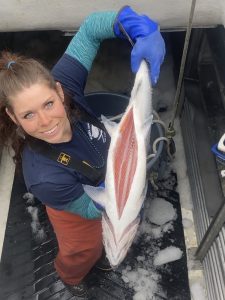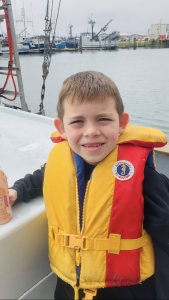January 26, 2023
The power couple reflected on how, for them, fishing is a craft that is passed down through generations and rooted in community
By Andrea Richter-Sanchez, WSG Science Communications Fellow

Amy Sharp showing off her fresh caught salmon
They say nothing brings people together better than good company over a warm home-cooked meal, and that story was no different for John Alto and Amy Sharp. John, a troller fisherman, one day got a call from a friend inviting him over to a troller family dinner. Troller vessels generally fit only one to two people, therefore it is common practice for one boat to cook a “family dinner” and invite other nearby trollers in their community. It was Amy’s captain who gave John that call, where Amy happened to be preparing dinner for the group. “I take a lot of pride in bringing in quality seafood to my community,” Amy says. “My favorite thing I do in this life is to feed others, and this is my way to feed my community.” Amy and John met as they shared a plate, and have been together ever since on their boat F/V Spring Persuader for their company Heritage Ocean.
Both John and Amy have a deep passion for their ocean and they act on it by providing quality fish back to their community, just as both their families have done for generations. John’s family history has long been tied to fishing, and he wanted to follow in that tradition. His great-grandfather immigrated from Finland and went to sea when he was 13 to work as a cabin boy on tradeships. He left the boat in San Francisco and made his way to Astoria, Oregon. Later, his son (John’s grandfather) purchased a salmon and albacore troller in 1936. That boat was lost from a crash, but that did not stop John’s grandfather. He continued fishing. The legacy continued and his son, John’s father, bought a dory boat for commercial salmon trolling. Later on, John’s father purchased a 40-foot troller and got into gillnetting until the mid-1990s.
With such a rich and long family tradition of fishing, it seemed only natural that John would work as a full-time deckhand every summer from age 12. When he was 18, he decided to venture out and explore the unknown by leaving his hometown. He headed to Bristol Bay, Alaska for five seasons of commercial fishing. He served four years on the Oregon Department Fish and Wildlife’s Restoration and Enhancement Board as their Salmon Troll Representative. He has been in the commercial fishing industry ever since, and is now the Vice President of the Washington Trollers Association.
John fished alone for 20 years, until he met Amy. Like John, Amy’s grandfather was also a fisherman. She has spent her whole life around commercial and recreational fishing, When the pandemic hit, she decided it was time for a change: she left her job as an electrician to permanently transition into the commercial fishing industry. Amy and John fish throughout the Pacific Northwest now and are the definition of a power couple by working together in a laborious and intense field to provide for their community.

John’s boat: F/V Spring Persuader
Trollers are boats that fish for salmon by towing lures or baited hooks through the water. Fishing lines are rigged to a pair of outriggers (trolling poles), which, when lowered, hold the fishing lines away from the boat. Many trollers have a pit in the stern so that fishermen can steer while operating the gear. Trollers are unique because they are one of the only fisheries where someone can captain and crew their boat themselves. Trollers can be lonely since they only hold one to two people and the majority of these boats are operated by only one person. As a result, trollers often develop a tight community amongst themselves.
“The sense of community for trollers evolved from our need for survival as our seasons got shorter, the state fishing regulations got tighter, and the fish runs became more depleted,” John says. He notes how nice it is to have that comradery, since they tend to be very nomadic. Trollers travel from Alaska all the way down to Monterey Bay, California to follow the salmon. John explained, “When you are not catching fish, that ocean surrounding you becomes real big, real quick. That is when we use our group to find fish and help each other out; which is how we’ve been able to survive in the troller industry.” Amy adds: “This is how they become your family.”

Couple: John Alto and Amy Sharp
Amy and John are one of the few couples who do this type of work together, and so they have developed a unique dynamic. “You are spending 200 days a year in an extremely small space. It is best to compare it to those couples who live in those extremely small houses, but you can’t leave the house because you just have the ocean around you. These boats are not made for comfort, they are made to pack fish,” John says.
“Catching salmon is a uniting force for John and I,” Amy says. “It’s a shared interest and a shared experience. John and I spend more than half our year living with, working with, and relying on only each other every second of every day. When the season is over we struggle going our separate ways because we are so used to operating side by side as one well oiled machine.” They both expressed how lucky they are to get along so well together and have the opportunity to work together. It always helps to have a second set of hands and can often be what saves you in intense situations.
Spending his whole life in this fishing community, John has seen how much the industry has changed over the years. When John was a kid, commercial fleets used dory boats, but then Oregon put a moratorium on fishing coho salmon in the mid-1990s and that ended the commercial dory fleet. Now dory boats are only used for recreational fishing in Oregon. One of the biggest changes they faced was the introduction of farmed salmon. “Farm salmon flooded the market with cheap fish, even if they had to sell them at a loss to get into the market,” John says. When John first bought his own boat back in 2001, they were selling troll-caught king salmon for $1.25 a pound, less money than what they were getting in the early 1970s. “It was important to have the consumer realize that there is a difference between wild caught salmon and farm- raised salmon. It was fifteen years before we were able to get the markets back and gain the price back,” John says. They started to get a better return of fish in 2002 because the hatcheries started to change their management practices.
Today, we are seeing a change in salmon populations affected by many factors, such as climate change, past management practices, hatcheries, infectious diseases, and dams. Amy and John have been fortunate to have good seasons these past few years in spite of all the challenges present in the fishing industry today. They are optimistic that they will continue to have good fishing seasons because of the new fishery policies that have been implemented.

Amy’s son enjoying a fishing day
Amy hopes the industry will stay strong and that the fish stocks will continue to be stable because she wants her son to have his opportunity at sea. Generally, the commercial fishing industry is male dominated. However, that did not stop Amy from working to give back quality seafood to her community. Amy loved fishing so much that she stayed as a deckhand throughout the majority of her pregnancy with her son.
“When my son was in my belly, he would act more peacefully on the boat than on land. Later, when he was a baby, he would fall asleep immediately on the boat because that is where he was the most comfortable,” she says. Amy is adamant about wanting to protect the fishery so that her son may inherit it in the future: “My son wants to fish, he is the future of this fleet, and it is my job to protect it for him.” She loves her job because of how it lets her pursue her passion, feed her community, and give her the flexibility she needs as a mother. “This industry allows me the freedom that I need to be the mother I want to be for my child. As a woman in this industry, that is something that I feel is very unique and beautiful about being a part of it.”
The future of the fishing industry is not stable, just like many other industries affected by climate change and by the increase of the industrialization of food. While Amy feels very protective of the industry for her family, she also thinks that the public has a role in helping to preserve the industry. The couple explains that the best way for people to participate in keeping salmon runs healthy, is to buy local, wild-caught salmon. “There is a disconnect with people not knowing where their food comes from in general, not just in the fishing industry. There is a huge problem in the U.S. about mislabeled products and this includes the mislabeling of fish,” John says.
Buying seafood that is in season makes a positive difference for local fishermen like Amy and John. “The consumer uses their wallet as a way of voting for what they want. They create the demand,” John says.. Both the consumers and the fishermen who bring us our seafood want sustainable fishing practices: fishermen want good management practices and conservation in order to keep their fisheries going, while consumers want ongoing access to fresh fish. The main objective of people like Amy and John is to bring a good quality product to the consumer, and luckily for us, that is what they do best.
###
Washington Sea Grant, based at the University of Washington, helps people and marine life thrive through research, technical expertise and education supporting the responsible use and conservation of coastal ecosystems. The National Sea Grant College Program is part of the National Oceanic and Atmospheric Administration, U.S. Department of Commerce.
www.wsg.uw.edu.
Join the conversation: @WASeaGrant and Facebook.com/WaSeaGrant.
JAN
2023